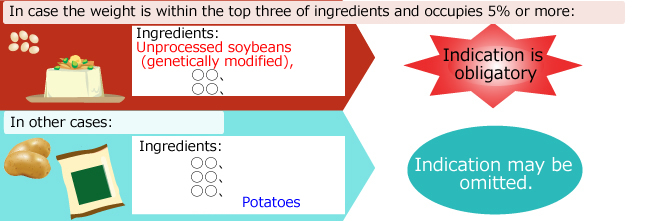Tokyo Food Safety Information Center » Tokyo Metropolitan Government food safety FAQ » How is the labeling of genetically modified (GM) foods defined in laws and regulations?
How is the labeling of genetically modified (GM) foods defined in laws and regulations?

How is the labeling of genetically modified (GM) foods defined in laws and regulations?
- Why do some foods have the labels indicating genetic modification while the others do not?

Labeling of GM foods is obligatory.
However, labeling may be omitted in case of soybean oil and soy source products, in which the modified genes, etc., are removed or decomposed in the manufacturing process, and in case of foods that are not defined as the major ingredients (within top three by weight ratio and 5% or more in addition).


Pursuant to the Food Labeling Act, labeling of genetic modification is obligatory for 33 specific articles including tofu and popcorn products, out of the following eight crops and the processed foods using these crops as ingredients: 1) Soybeans (including edamame (green soybeans) and soybean sprouts), 2) corns, 3) potatoes, 4) rape seeds, 5) cottonseeds, 6) alfalfas, 7) sugar beets, and 8) papayas.
Even in case of processed foods using these eight crops as ingredients, however, labeling is not obligatory for those processed foods, such as soybean oil and soy source products, from which the modified genes and the protein produced therefrom are not detected after processing.
In addition, even in case of the processed foods for which labeling is obligatory, labeling may be exempted if the genetically modified crops are not the major ingredients. Note that a “major ingredient” is an ingredient within the top three ingredients by the weight ratio and at the same time occupies 5% or more of the total weight of the ingredients.
For the concrete names of the food products, etc., for which labeling is obligatory, refer to “Common Q&A concerning food labeling (Volume 3: Labeling of GM foods)” (pp. 14-16, PDF) by the Consumer Affairs Agency.